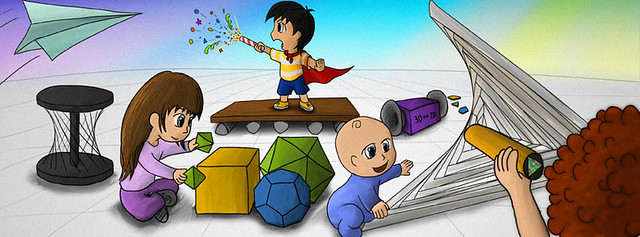Newsletter October 30, 2012

Welcome to adventurous math for the playground crowd! I am Moby Snoodles, and I love to hear from you at moby@moebiusnoodles.com
Book news
All the games for our book are ready, including illustrations. And we are working on the cover design. What else does our book need then? One thing we added in this development cycle is our special dictionary. We strive to be very correct mathematically. This means using a lot of beautiful math words, like fractal or exponentiation, which some readers may not know. Moreover, like every other big project, Moebius Noodles adds specific metaphors and meanings to terms. Thus even the readers who know the beautiful math words may find our definitions interesting.
For example, here are a few definitions that have to do with functions.
Function
Function is a machine that converts values to other values, or finds correspondences between values. Function machines work by rules people make up. The starting values are called input. The converted or corresponding values are called output. Your stove is a function machine: its input might be raw eggs, milk and spices, and its output – an omelet.
Transformation
When you change or combine rules, functions can be transformed. For example, you can turn your stove to the maximum setting and its timer to half an hour. Your input will stay the same – raw eggs, milk and spices; but your output will now be burned eggs and lots of smoke.
Inverse Function
What a function does, its inverse will undo. Of course, some deeds cannot be undone. A function of “baby drops a cup of grapes on the floor” has an inverse, “parental unit crawls around, searching for grapes and putting them back into the cup”. On the other hand, a function of “drop a cup of orange juice on the floor” or a function of “break an egg for the omelet” does not have an inverse.
Our blogs
Barbara of Numberland.net left us a note. Parents love their kids, so they create very lovely math projects for them – and then for the world! Numberland ideas, based on a University of Heidelberg research project parents and teachers have adopted, go with our chapter on intrinsic numbers.
Math is a wonderful, emotional, exciting and beautiful field and young children are more than open to dive into it. It is up to us to support them build their (individual) bridge from their inborn mathematical understanding to the abstract and formal language of math we developed. I very much like the approach of Moebius Noodles because it fits with the idea of a project I am involved in:
‘Let’s visit Numberland’ is a concept where we invite children to travel to a land where the numbers 1 to 10 live and where there is a lot to do, sing, find out… For example, we detect that Number 4 lives in a square garden, her house has four windows and she likes anything that is four times (…)

My daughter was three when she travelled to Numberland for the first time, and of course three was her favorite number. One day, at dinner table, she suddenly beamed: ‘We are sitting in a triangle!’ (Her, my son and me were sitting at the table) ‘And if Daddy was here we would sit in a quadrangle!’
Sharing
You are welcome to share the contents of this newsletter online or in print. You can also remix and tweak anything here as you wish, as long as you share your creations on the same terms. Please credit MoebiusNoodles.com
More formally, we distribute all Moebius Noodles content under the Creative Commons Attribution-NonCommercial-ShareAlike license: CC BY-NC-SA
Talk to you again on November 15th!
Moby Snoodles, aka Dr. Maria Droujkova
Related Posts
Posted in Newsletter









Leave a Reply